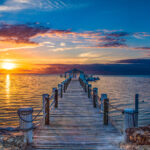Miamians are certainly not ones to sit still. How could they, when year-round warm weather and miles of sand and sea seduce them to play? But vacationing in Miami also often seems synonymous with navigating the club scene that’s still colorful at 5 a.m. When I visit, I try to stay at a low-key hotel, the Angler’s Boutique Resort, and spend my time at these nature spots that are plenty vibrant:
1. In 415-acre Bill Baggs Cape Florida State Park, four miles of trails course past a subtropical forest of gumbo limbo and pigeon plum trees and mangrove wetlands that once flourished in Florida. You’re bound to spy numerous butterfly species and maybe even a rare peregrine falcon.
2. The two-mile Fossilized Reef Trail winds to a unique geological feature — visible at low tide — at Crandon Park’s Bear Cut Preserve. On the way, you’ll likely encounter a variety of birds, from white ibis to cormorants.
3. Just 20 minutes from downtown, Oleta River State Park is a perfect venue for kayaking along the mangrove-lined Oleta River. This is also one of the state’s best spots for mountain biking with some 14 miles of interconnecting single track beside waterways where you may spot dolphins or manatee.
4. At the Deering Estate — once owned by philanthropist Charles Deering — naturalists lead treks into a tropical forest where you’ll see a Tequesta burial mound from 10,000 years ago, an avocado tree grove from the 1930s, and a solution hole where they found wooly mammoth and campfire evidence from Indians 10,000 years ago. Guides lead numerous other treks, including bird and butterfly walks.
5. Villa Vizcaya, a land of excess owned by Charles’s younger brother, the industrialist James Deering, recreated a 16th century Italian villa with rooms filled with European furnishings from the 16th to 19th centuries. The gardens, however, are the highlight of the estate with elements of 17th century French and Italian landscaping. Here you can spend half a day roaming the 10 acres dotted with lily ponds, cascading water, topiary, even a maze garden, and stone grottos.
6. Set on some 83 acres, the Fairchild Tropical Botanic Garden is home to a lush rainforest, the largest such outdoor forest in the continental U.S. More than 200 plants from the Caribbean, South America and Asia can be found on this property, including unique specimens, such as the rainbow eucalyptus with its colored trunk; and the powderpuff tree, candy corn vine and petticoat palm — you won’t wonder how each received its name.
7. You’ll have a whole new perspective on plant life after visiting the Fruit and Spice Park. The park is noted for many unique species, including the lipstick tree, which is considered the poor man’s saffron, and the custard apple that has black fleshy fruit. This is a very interactive park where visitors can sniff bay rum leaves, and sample jackfruit, guava, chocolate pudding fruit and sapodilla.
— Jeanine Barone of J The Travel Authority
Photo Credit: Top Photo: Flicker/Kat… Bottom Photo: Flicker/Gardening in a Minute
All products are independently selected by our writers and editors. If you buy something through our links, Oyster may earn an affiliate commission.




